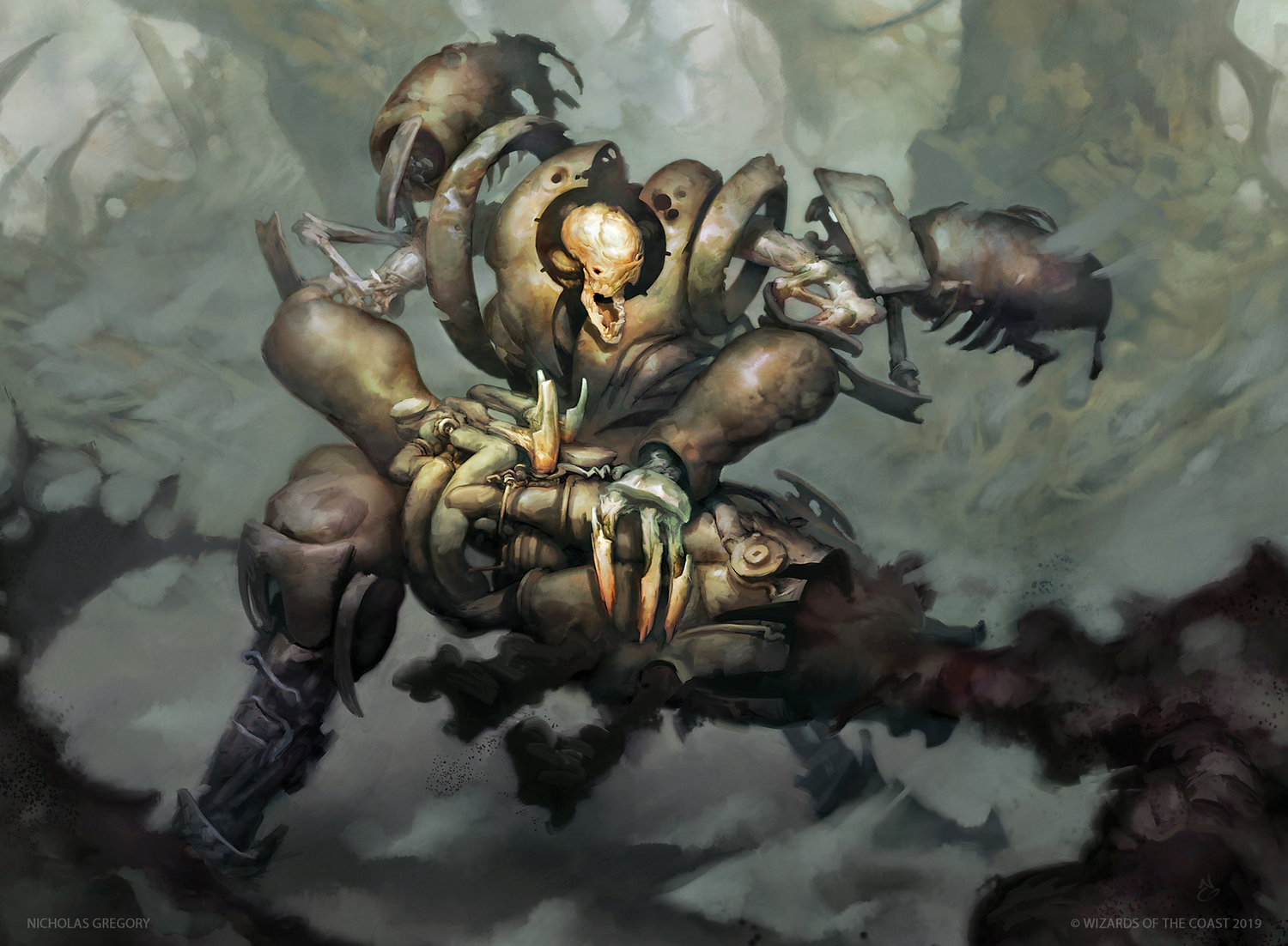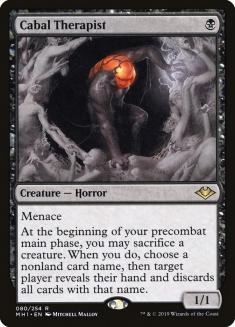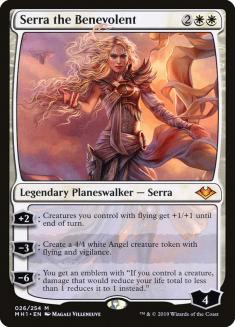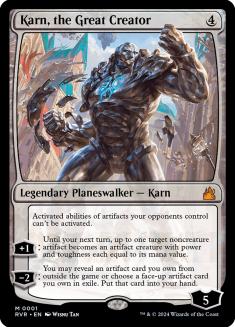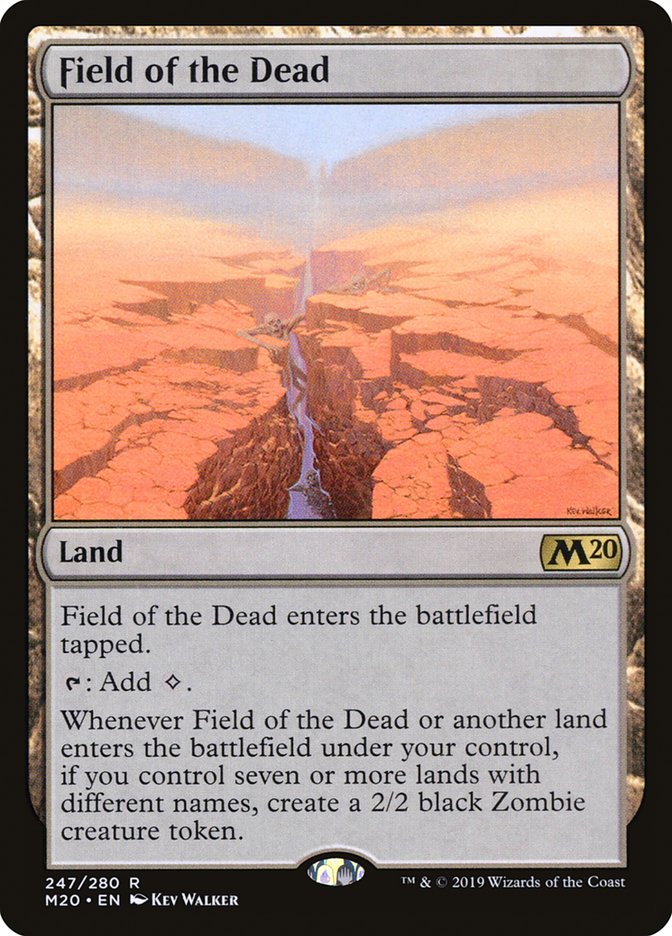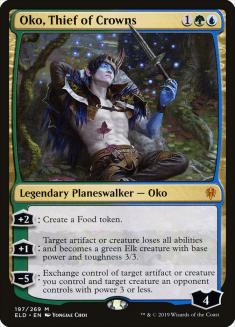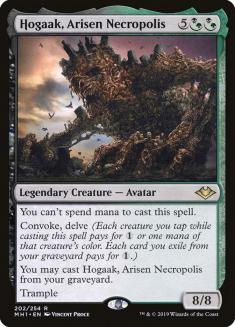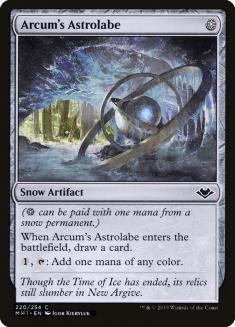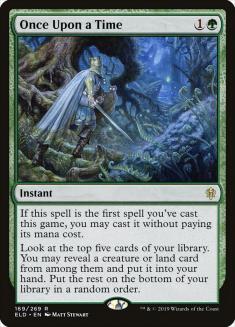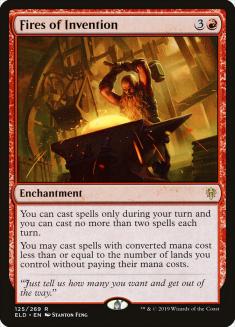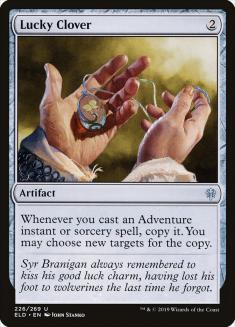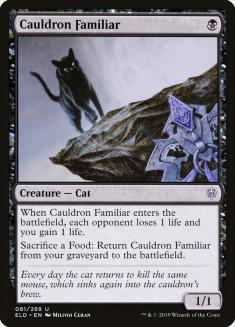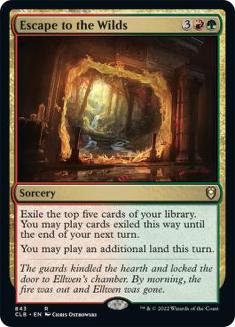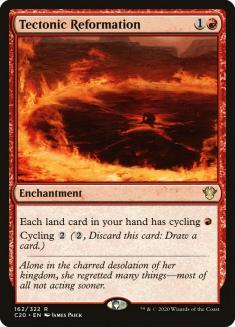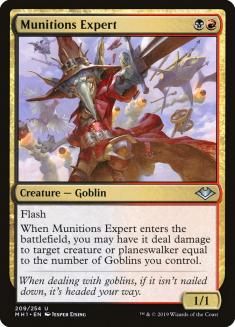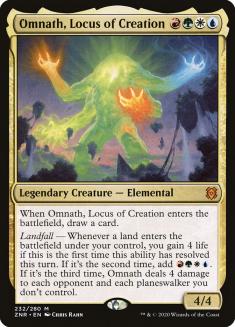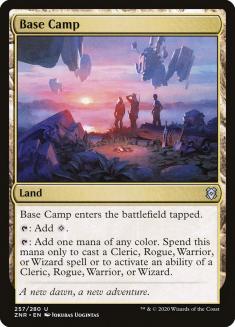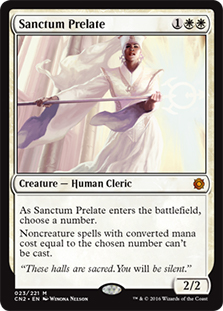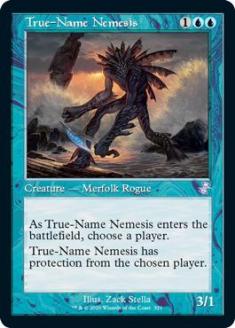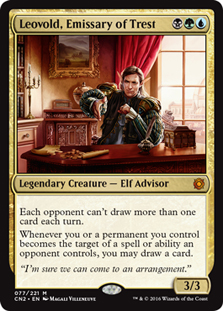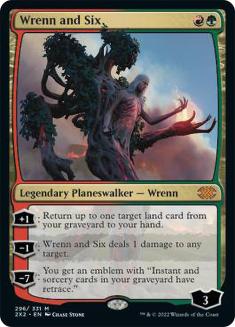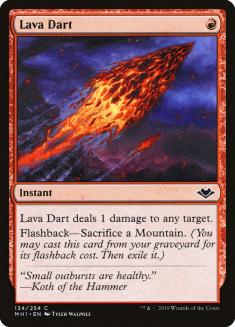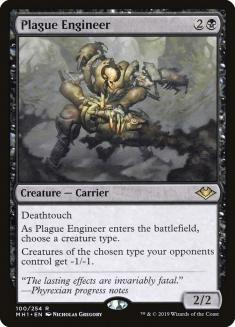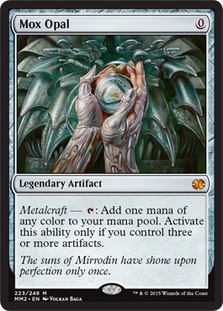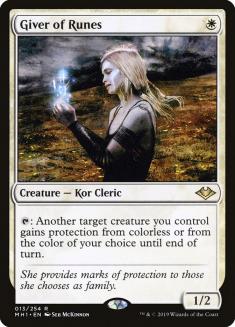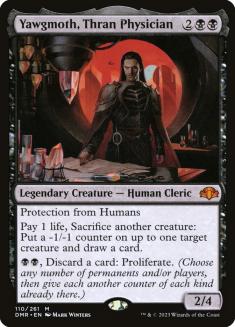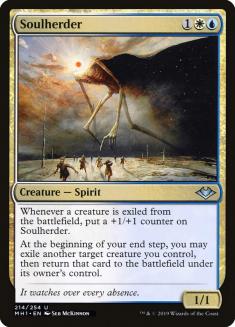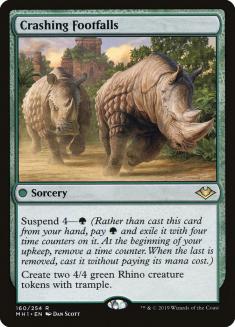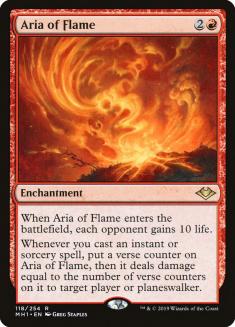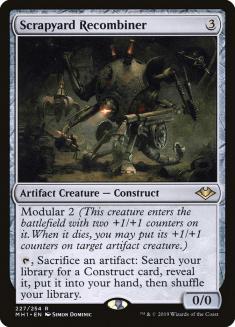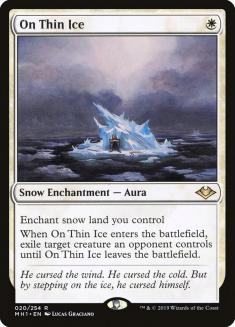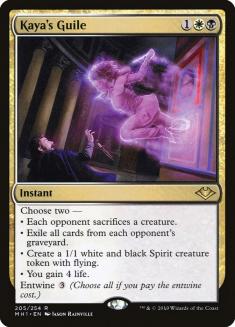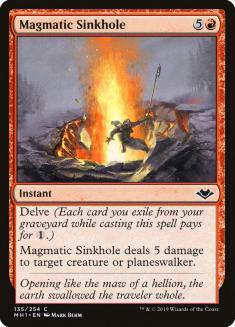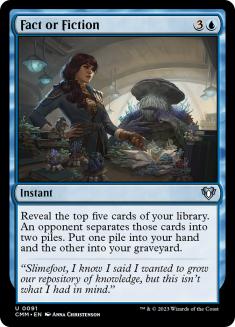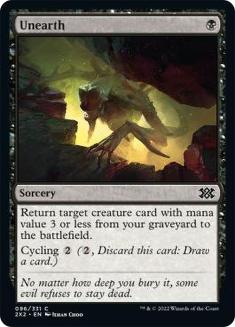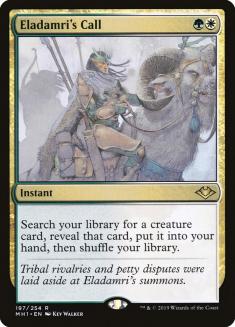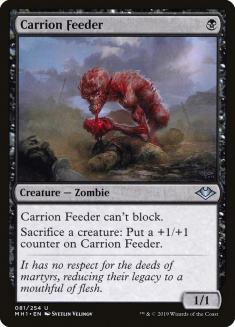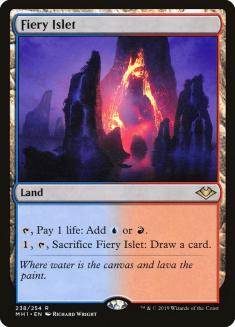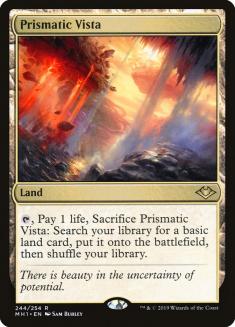Modern in May 2021 is eerily stable. There’s some debate over what the best deck is. All of the main macro-archetypes have representation in tournament results. There’s a predictable metagame you can attack but you can cram all manner of nonsense in your 60 (or 80!) cards and see success. It’s easy to forget that there was an earth-shattering round of bans just three months ago.
What better time to turn the format on its head once again?
The first Modern Horizons arrived at a relatively quiet time for Modern. Security had just escorted Krark-Clan Ironworks from the building. Creeping Chill and Arclight Phoenix drew ban discussion away from Ancient Stirrings onto Faithless Looting, yet both cards seemed safe in the short-term. If something went, it would be a newcomer, not a popular and established pillar of the format. Modern Horizons had a low bar to clear to become the most impactful set for Modern in the past few years.
Instead, Modern Horizons became just one of a series of set releases that each had massive implications everywhere (with permanent change — or damage — in the non-rotating formats). Pre-War of the Spark Modern fundamentally differed from post-War of the Spark Modern, and the same held true for each set through Ikoria: Lair of Behemoths a year later. Remove Modern Horizons from this sequence and you lose some of the worst offenders and stop some of these mistakes from compounding each other — how dominant is Uro, Titan of Nature’s Wrath in a world without Force of Negation? — but the format would still suffer an identity crisis as its structural weaknesses were tested more strongly than ever.
The London Mulligan adds a further complication, an incredibly important change but one whose exact consequences are hard to pin down. Its debut at Mythic Championship II gives a useful contrast with that same format under the Vancouver Mulligan but its formal adoption came in the middle of Hogaak, Arisen Necropolis’s second term. We don’t know what this time in Modern would have looked like with Modern Horizons but without Hogaak twisting the format beyond recognition. With so much going on at once, Modern Horizons may be taking the blame for other problems.
As we prepare ourselves for Modern Horizons 2, it’s worth looking back at Modern Horizons to inform our expectations.
Competitive Magic remembers sets for their failures. If 2019-2020 was a turbulent time for Constructed players, it was a bonanza for everyone else from Cube designers to Commander fans. Who cares if Hogaak, Arisen Necropolis is obscenely powerful when you decide what belongs in your format or at your table?
If you enter a serious Modern tournament, you must care. The presence of other interesting but more balanced designs in the set is hardly reassuring. The incentives of competitive play pose a different question: who cares if there are some cool graveyard synergies in this set when Hogaak does the same thing in a much better way and ensures that Leyline of the Void is the most popular card in the format?
A set only needs one or two cards to go too far for that to become its legacy. Theros Beyond Death would rather be remembered for Kroxa, Titan of Death’s Hunger than Uro, Titan of Nature’s Wrath. War of the Spark will forever be associated with the frustration of Narset, Parter of Veils and Teferi, Time Raveler.
Of course, there can only be so many exceptions. When six of your cards are banned in a format and you still have a stranglehold on it, you can’t blame a few bad apples. The whole tree is rotten to the core.
Modern Horizons doesn’t fit neatly on this spectrum. Hogaak and Arcum’s Astrolabe were both clear mistakes but they have nothing else in common. Some of its big hits are hard to classify. Urza, Lord High Artificer certainly looked like a mistake when it dominated the format, but the loss of Astrolabe and Mox Opal tamed it. Other cards like Plague Engineer will never meet some specific criteria for banning but will create negative experiences and close off possibilities in the format indefinitely.
Naturally, we remember the cards pushed too far better than those that could have made a mark if they were pushed further. It’s easy to imagine a world where Life from the Loam is a $50 card and Goblin is the most common choice for Cavern of Souls. This is a different kind of failure that looms over every set — Strixhaven’s total lack of impact in Standard is a problem — but especially so for a Modern Horizons set whose stated purpose is shaking up the format. There’s little chance of this one suffering Strixhaven’s fate but individual cards or archetypes underperforming can throw off the uneasy balance a set aiming this high has to strike.
When you push everything, it’s hard to miss completely but relative power level still informs which cards get a chance to shine. Omnath, Locus of Creation would be obscenely powerful and Base Camp offensively weak in the abstract, but seeing them in the same file given the recent Standard context of ramp being oppressive and aggro nonexistent makes their respective failures more aggravating.
Mistakes in supplemental sets feel more inevitable, and perhaps more egregious, because they avoid the usual processes meant to make them safe for Standard. Cards whose power scales with the size of a format will slip through these cracks regardless (Chalice of the Void was trash in Standard but defines Legacy and Vintage to this day) but this should weed out the worst offenders.
For some, a card’s impact on other formats should be organic, even accidental. The charm of deckbuilding is finding an obscure rare from Mirrodin that hooks up with a flagship card from Kaladesh to power the hot new deck; if Modern Horizons thrusts that card into your hand and tells you exactly how to use it, it feels less authentic.
I don’t find that convincing now that this safety valve has fully burst. Cards like Oko and Uro were absurdly strong in Standard and took their talents to every other format. Meanwhile, a straight-to-Modern set gives innocent role-players like Firebolt a route into Modern that they would never find otherwise.
When several strong cards directly or indirectly work towards the same goal, their combined effect can be greater than intended. It’s obvious that Lava Dart is strong against one-toughness creatures and there’s nothing inherently wrong with that — cards get printed, other cards get better or worse — but it’s a tough time to sleeve up Noble Hierarch and Thalia’s Lieutenant when the default aggro deck has Lava Dart, a new wave of midrange and control decks is powered by Wrenn and Six, and any deck that can cast it wants Plague Engineer.
Plague Engineer is, in its own way, the most baffling card in Modern Horizons. The set explicitly supports tribal themes, with Changelings tying together everything from Goblins and Zombies to Slivers and Ninjas. In his Drive to Work podcast episodes on Modern Horizons, Mark Rosewater highlights our own Michael Majors’s role as a Modern correspondent for the development team, arguing that Goblins could be a player with enough support. Tribal decks are widely popular — it’s no accident that they’re a recurring feature of new sets even when they don’t need to be — and can be managed by cards like Lightning Bolt and Fatal Push without the need of the set’s other superweapons like Collector Ouphe or Force of Vigor. The rest of this set is already hostile to small creatures, so what was this meant to protect us from?
This is a symptom of a larger problem that made Modern Horizons’s task impossible; it had to rip up the foundations of a format whose popularity relies on a kind of continuity. The most competitive players will pick up whichever broken deck is on borrowed time or jump to some strategy well-placed for a particular weekend, but the consistently high attendance of Modern tournaments rests on the silent majority of players who know and love ‘their’ Modern deck.
The fact that you could play your Jund or Affinity cards from five years ago and still have a puncher’s chance kept players in stores through Modern’s frequent earthquakes and made it easier to justify the substantial investment needed to enter the format. If you did want to branch out, these big-ticket items gave you choices — Cavern of Souls or Aether Vial could support other tribal decks like Bant Spirits, while Mox Opal could show up everywhere from Hardened Scales to Lantern Control.
Consider the end of Arcbound Ravager’s career. Between them, War of the Spark and Modern Horizons brought Karn, the Great Creator; Collector Ouphe; and Force of Vigor — extreme answers in search of a problem. They found their mark in Urza, Lord High Artificer, which launched an artifact-centric deck (that happened to line up perfectly against Affinity) to the top of the format and demanded a tough response from its competition.
Mox Opal was eventually banned as an accomplice to Oko and Arcum’s Astrolabe in Simic Urza, which didn’t even care about cards like Collector Ouphe or Force of Vigor. The main culprits (Oko and Astrolabe) are banned too while Urza gets to live out a quiet retirement, but any innocent bystander that relied on Mox Opal is turned into a smouldering wreck. Even if Affinity had somehow crawled out of the ashes, Signal Pest and Vault Skirge are easy prey for Lava Dart and Plague Engineer…
If you played Modern once a week at your local store with the Cranial Platings you’ve had since 2004, Modern Horizons might have been the beginning of the end of your engagement with the format. I saw a lot of those people at every SCG Tour stop in 2019; I don’t expect to see them in person again.
Modern Horizons 2 doesn’t have the same problem. Thanks to the impact of Modern Horizons and every other set in that period, the pandemic stopping people from playing Modern at all, and the hard reset enforced by the February 2021 bans, Modern now has no real institutional memory. As Ari put it: if Modern Horizons 2 blows up the format, at least it was a new development that nobody was attached to. They can afford to take more chances this time and they can take more informed chances now.
If it’s easy to remember a set for its misses, we should make an effort to remember the hits — not least because they offer a template to build on in Modern Horizons 2.
Pitched as Time Spiral/Future Sight 2, Modern Horizons was always going to feature callbacks and redesigns. Giver of Runes is a great example of an update to an iconic card that fills a useful role in the format while losing the most obnoxious part of its mother’s play pattern.
Cards that spawn entire archetypes by themselves without any complaints are exactly what this set should be aiming for.
There’s no better place to stash the weird and wacky cards that do something very specific. Very few decks want Crashing Footfalls and no other set could have Crashing Footfalls but it adds something unique to the file and the format at the cost of just one slot.
As threats get more powerful — with sets like this leading that charge — broad and efficient answers that still have strengths and weaknesses are vital. Kaya’s Guile in particular has earned attention and praise recently as a card that does something useful almost everywhere with some modes being situationally incredible but without smothering the cards or archetypes it’s best against.
The early 2000s sets from just before the Modern cutoff are full of cards that feel like they should be in Modern — and which you often start a decklist with before you catch yourself — and this is a direct pipeline to let a new audience enjoy those cards on a big stage.
A format as large and fast as Modern deserves mana fixing that’s more than whatever new land cycle was just released into Standard or the fetchland + shockland manabases that have defined the format since its inception.
The first batch of Modern Horizons 2 previews has something for everyone — a universally strong reactive card in Counterspell and a mind-melting build-around in Urza’s Saga. As we eagerly wait for more previews to drop, there are reasons to be cautiously optimistic. The team working on Modern Horizons 2 has useful lessons and cautionary tales from the original Modern Horizons as well as all the other sets that pushed the envelope. A formidable roster of players and game designers — including many former and current Star City Games writers — worked on the set in some capacity.
That by itself is not enough. The problem with previous sets that missed the mark was never a lack of talent, and many tales of organizational failure start with noting how everybody in the room would be the smartest person in any other room. Successful gamers and game designers can optimize for a given goal if they have the resources they need, but the senior figures setting those goals may have priorities that don’t align with mine or yours. I’m more optimistic on that front than I was before, but we should make sure our fingers are pointed in the right direction when some menace we don’t even know about yet earns an emergency ban in a month or two.

